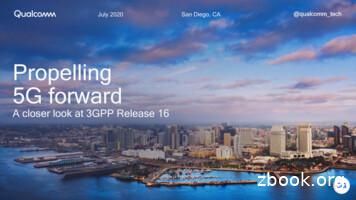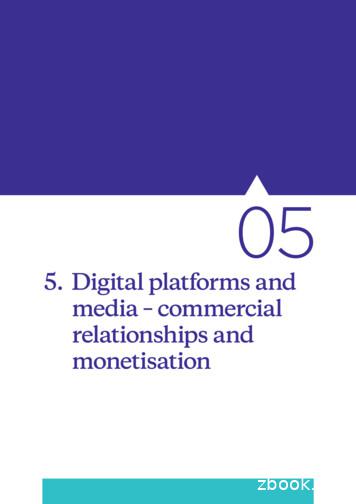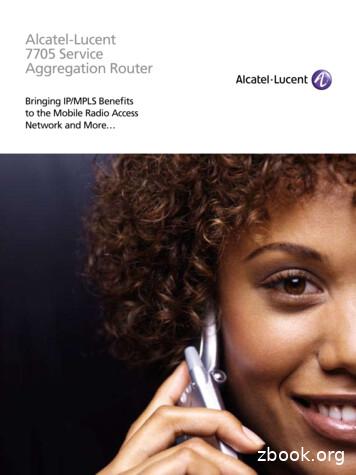Carrier Aggregation And Dual Connectivity - NTIA
Carrier Aggregation and Dual Connectivity Rapeepat Ratasuk and Amitava Ghosh Mobile Radio Research Lab, Nokia Bell Labs ISART 2017 1 2017 Nokia
Carrier Aggregation and Dual Connectivity Carrier Aggregation (CA) was introduced in 3GPP to allow a UE to simultaneous transmit and receive data on multiple component carriers from a single eNB - CA can increase user throughput as the aggregated bandwidth is increased Dual Connectivity (DC) was introduced in 3GPP to allow a UE to simultaneously transmit and receive data on multiple component carriers from two cell groups via master eNB (MeNB) and secondary eNB (SeNB) - DC can increase user throughput, provide mobility robustness, and support load-balancing among eNBs f1 f2 a at ol D ntr o C Component Carrier f1 eNB Da ta MeNB f2 SeNB Backhaul (X2) Carrier Aggregation 2 Dual Connectivity
Carrier Aggregation Carrier aggregation (CA) allows combining of multiple component carriers - Increasing bandwidth and enhancing data rates for users. - Support for non-contiguous CA to more efficiently utilize fragmented frequency resources – more options for spectrum re-farming. - Multiplexing gain by dynamically distributing traffic over multiple carriers. LTE-Advanced maximum bandwidth Rel’8 BW Rel’8 BW Rel’8 BW Rel’8 BW Rel’8 BW Carrier 1 Carrier 2 Carrier 3 Carrier 4 Carrier 5 LTE-A supports CA of up to 5 carriers while LTE-A Pro supports CA of up to 32 carriers LTE-A also allows CA of TDD and FDD carriers, inter-band TDD CA with different UL-DL configurations, and CA with multiple uplink timing advance values. CA provides the basic framework for Licensed Assisted Access (LAA) where LTE is deployed in unlicensed band as a secondary cell 3 Release Max No of Carriers 5 (up to 100 MHz) 32 LTE-A Pro (up to 640 MHz) LTE-A Peak DL Rate 2x2 MIMO 8x8 MIMO 1 Gbps 3.9 Gbps 6.3 Gbps 25.1 Gbps
CA Performance User performance with intra-band and inter-band carrier aggregation – Marginal Avg. TP loss in Rel8 by assigning cell center UEs on 2.1GHz carrier 2x10MHz, 2 GHz, median user throughput 4 2017 Nokia 2x10MHz, 2.1 & 0.8 GHz, mean user throughput
eNB macro (licensed, F1) LTE-U/LAA deployment scenarios Use cases The main application areas are outdoor and indoor public small cells and corporate cells LTE-U and LAA are always co-located (or connected via ideal backhaul, i.e. baseband is co-located) with a licensed carrier LWA also includes scenarios where the licensed carrier is not co-located with Wi-Fi with non-ideal backhaul between the cells. eNB micro/pico (licensed, F2) Ideal backhaul (Non-co-located) Ideal backhaul or co-located) LTE-U/LAA cell (unlicensed, F3) 2017 Nokia UE LTE-U/LAA cell (unlicensed, F3) eNB macro (licensed, F1) eNB macro (licensed, F1) Ideal/non-ideal backhaul Ideal/non-ideal backhaul eNB pico (licensed, F1) eNB pico (licensed, F2) Ideal backhaul or co-located Ideal backhaul or co-located LTE-U/LAA cell (unlicensed, F3) 5 UE UE LTE-U/LAA cellU-plane (unlicensed, F3) UE
Indoor scenario with DL only traffic: loading W W means 2 Wi-Fi operators W L means 1 Wi-Fi and 1 LAA operator L L means 2 LAA operators LAA operators are asynchronous Definition of fairness: performance of the first Wi-Fi operator does not decrease when the second operator’s Wi-Fi is replaced with LAA Low/medium/high loading is defined in 3GPP by buffer occupancy ranges of the first operator in the W W case. The definition is a little unfortunate, as Wi-Fi is noticeably overloaded already at medium load. Loading per cell Loading per user * 2.5 6 2017 Nokia
Outdoor scenario with DL only traffic: loading There is more interference in the outdoor scenario, and possibly longer distances to own AP/eNB. Fairness and performance trends are similar to what we see in indoor scenario. Outdoorscenario: scenario: Outdoor 21sites, sites,500m 500m 21 ISDISD One cluster per site, 140m diameter One cluster per site 4140m APs/eNBs per cluster/operator cluster diameter minimumper intra-op. distance 420m APs/eNBs cluster/operator 10m minimum inter-op. distance 10 users per cluster/operator 10 users per cluster/operator 20MHz unlicensed band 20MHz unlicensed band 18dBm 5dBi 18dBm 5dBi 7 2017 Nokia
Dual Connectivity Architecture Only one C-plane S1-MME connection per UE - RRC connection via MeNB only, SeNB connection is controlled through MeNB Two DC user-plane architecture options are supported - 1A – S1-U termination at MeNB and SeNB (analogous to carrier aggregation) - 3C – S1-U termination at MeNB, bearer split in RAN (analogous to off-loading) Architecture MME S-GW C-plane 8 U-plane MME S-GW C-plane U-plane S1-C -U S1 S1-U S1-C -U S1 MeNB X2-C SeNB MeNB X2-C X2-U UE UE 1A 3C SeNB U-plane Protocol Stacks S1 S1 PDCP PDCP PDCP PDCP RLC RLC RLC RLC RLC MAC MAC MAC MAC MAC MeNB SeNB 1A S1 MeNB SeNB 3C
Mobility Robustness with Dual Connectivity Study of handover failures with dual connectivity - considerably less handover failures with dual connectivity since UE remains connected to macro-cell Without Dual Connectivity Tokyo 2.5 2.0 1.5 3.0 3GPP 3.5 London Tokyo 2.5 2.0 1.5 3.0 2.5 2.0 1.5 4.0 3GPP 3.5 London Tokyo3.0 2.5 2.0 1.5 HOF Percentage 3.5 London 4.0 4.0 3GPP 3GPP 3.5 3.5 London London 3.0Tokyo Tokyo3.0 2.5 2.0 1.5 Tokyo 1.5 1.0 1.0 1.0 1.0 0.5 0.5 0.5 0.5 0.5 0.5 0.0 30 kmph3 kmph London 2.0 1.0 3 kmph 3GPP 2.5 1.0 0.0 9 4.0 HOF Percentage HOF Percentage 3.0 3GPP HOF Percentage 3.5 (a) HOFs W/O DC(b) HOFs DC(a) HOFs W/O DC(b) HOFs DC (a) HOFs without DC 4.0 HOF Percentage (a) HOFs without DC 4.0 With Dual Connectivity HOF Percentage 0.0 0.0 0.0 0.0 60 kmph30 kmph 3 kmph60 kmph 3 kmph 30 kmph 60 kmph 3 kmph 30 kmph 3 kmph 30 kmph60 kmph30 kmph 60 kmph 60 kmph
LTE – NR Dual Connectivity Stand-alone NR - UE accesses standalone NR carrier and may not be connected to an LTE carrier. Non stand-alone NR (dual connectivity of LTE and NR) dual connectivity to also operate on NR - UE may be simultaneously connected to LTE and NR, or to LTE for control plane and NR for user plane LTE LTE 5G 5G Simultaneous connection to LTE and 5G 10 - UE accesses LTE PCell, then is configured by Control Plane User Plane 5G LTE for control plane and 5G for user plane
Option 3/3a/3x Overview Option 3 (MCG Split Bearer) Option 3a (SCG Bearer) LTE eNB NR gNB 4 Split Bearer S1-U U-Plane PDCPLTE PDCPLTE RLCLTE RLCLTE Xx LTE eNB NR gNB NR gNB 2 U-Plane SCG Bearer S1-U U-Plane MCG Bearer S1-U SCG Split Bearer S1-U S1-U Xx Xx PDCPLTE RLCNR RLCLTE MACLTE MACNR MACLTE LTE eNB SgNB (NR) LTE eNB S1-U anchored at LTE eNB. Mobility signaling between LTE-NR not visible to EPC S1-U Split at LTE eNB. Increased load on eNB to process both LTE 5G User Traffic Xx interface needs to support CP and 5G user traffic, flow control and latency requirements Xx MCG Bearer S1-U 3 CP UP CP LTE eNB 2 MCG Bearer EPC EPC 1 EPC1 CP UP Xx Option 3x (SCG Split Bearer) UE mobility interruption (NR to LTE): Impact limited due to split/switched bearer in eNB i.e. traffic sent over LTE when outside NR coverage. 3 Nokia Internal Use PDCPLTE RLCNR RLCLTE MACNR SgNB (NR) S1-U anchored at gNB. Mobility signaling between LTE-NR visible to EPC due to S1 Path Switch. EPC needs to support E-RAB Modifications. S1-U not split and delivered over NR. No additional load to LTE eNB, no flow control needed Xx interface used for CP traffic only. UE mobility interruption (NR to LTE): Impact due to S1 Path Switch from gNB to eNB 4 11 PDCPNR PDCPNR RLCLTE RLCNR MACLTE MACNR LTE eNB SgNB (NR) S1-U anchored at gNB. Mobility between LTE-NR visible to EPC due to S1 path switch. EPC needs to support ERAB Modifications. S1-U Split at gNB. LTE eNB transmits fraction of user data. Xx interface needs to support CP and split user traffic, flow control and strict latency requirements. UE mobility interruption (NR to LTE): Impact limited due to split/switched bearer i.e. traffic sent via Xx to LTE when outside NR coverage. S1 path switch leads to impact.
CA/DC for NR Phase 1 Carrier Aggregation for NR Phase 1 Carrier Carrier Carrier Carrier Carrier Dual Connectivity for NR Phase 1 LTE MCG Carrier Carrier Up to 16 carriers (contiguous and non-contiguous) can be aggregated Up to 1GHz of spectrum can be aggregated Carriers can use different numerologies Transport block mapping is per carrier Cross-carrier scheduling and joint feedback are supported 12 5G SCG gNB is not required to broadcast system information other than radio frame timing and SFN System information is provided by RRC signaling via LTE master cell
Conclusions Carrier Aggregation Carrier aggregation (CA) allows a UE to simultaneous transmit and receive data on multiple component carriers from a single eNB CA allows network to increase bandwidth and utilize fragmented frequency resources, and provide higher data rates to UE. CA allows Licensed Assisted Access deployment using licensed and unlicensed spectrum. CA improves peak rates as well as user throughput at low load 13 2017 Nokia Dual Connectivity Dual Connectivity (DC) allows a UE to simultaneously transmit and receive data on multiple component carriers from two cell groups via master eNB and secondary eNB DC can increase user throughput, provide mobility robustness, and support load-balancing among eNBs 5G NR Phase 1 CA and DC are enabling technologies for 5G NR Up to 16 carriers and approximately 1 GHz can be aggregated for 5G NR Phase 1. Carriers with different numerologies can be aggregated. Dual connectivity of LTE and NR allows non-stand alone NR deployment for fast adoption of 5G NR and performance robustness.
Carrier Aggregation LTE-Advanced maximum bandwidth Carrier 1 Carrier 2 Carrier 3 Carrier 4 Carrier 5 Rel'8 BW Rel'8 BW Rel'8 BW Rel'8 BW Rel'8 BW Release Max No of Carriers Peak DL Rate 2x2 MIMO 8x8 MIMO LTE-A 5 (up to 100 MHz) 1 Gbps 3.9 Gbps LTE-A Pro 32 (up to 640 MHz) 6.3 Gbps 25.1 Gbps
introduction, the Carrier aggregation then has been introduced also in LTE-A in 3GPP Release-10. The overall goal of the Carrier Aggregation is on one hand, to provide enhanced and consistent user experience across the cell by: Maximizing the peak data rate and throughpu
Carrier aggregation (CA) and dual connectivity (DC) Faster link recovery in dual connectivity Enhancing Rel-15 CA/DC capability and performance Defining configuration, signaling, reporting procedure for early measurement, and blind resume, faster activation for secondary cell(s) Improving
News referral services can take the form of media aggregation services, online search services or social media services. These are explained below. 5.1.1 Media aggregation services A digital platform that supplies a media aggregation service collects and presents news content from across the internet. Most providers of media aggregation .
Alcatel-Lucent 7705 Service Aggregation Router Overview The Alcatel-Lucent 7705 Service Aggregation Router (SAR) is an edge aggregation platform providing superior IP/MPLS and pseudowire capabilities. It addresses your need for a cost-effective, scalable mobile radio access network (RAN) transport solution. The 7705 SAR excels at con-
Aggregation in Social LCA studies, SETAC CPH Nov 2012 1 Aggregation over the entire life cycle: In order to indeed get a holistic picture of the social impacts over the entire life cycle, aggregation is needed, because a life cycle model provides information for its smallest elements, processes, which are usually grouped into life
Carrier reserves the right to refuse to transport any shipment for any reason it deems reasonable, before consignment. After consignment, however, Carrier agrees to assume all liabilities for delivery of ca rgo intact. Broker agrees to pay Carrier as carrier's agent for services rendered with Carrier's invoice & legible, clean
Avionics: Honeywell 6-Tube EFIS. Enrolled on Honeywell HAPP. Dual Honeywell SPZ-8400 Digital Auto Pilot Dual Honeywell FZ-820 Flight Guidance Computers Dual Honeywell NZ-2010 LR NAV/FMS w/ 6.1 Software Dual Collins VHF-422B COMM (8.33 Spacing) Dual Collins VIR-432 NAV w/ FM Immunity Dual Collins ADF-462 Dual Collins DME-442
Automotive Sector Report 1. This is a report for the House of Commons Committee on Exiting the European Union following the motion passed at the Opposition Day debate on 1 November, which called on the Government to provide the Committee with impact assessments arising from the sectoral analysis it has conducted with regards to the list of 58 sectors referred to in the answer of 26 June 2017 .























